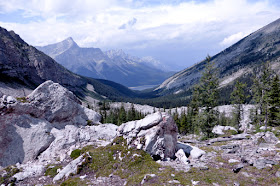At breakfast Joan and I discovered a beneficial change to the morning routine at Mount Engadine Lodge. Since our first visit in 2004, the fixings for assemble-your-own lunches were brought out only after everybody finished breakfast and the breakfast fixings were cleared away. This meant that the lunches weren't ready as early as they might have been, and delayed the start of our hikes. Combined with the fact that for most hikes you'll need to drive to the trailhead, it made for a late start for long treks. In the new system, you fill out a lunch checklist at the start of breakfast, and the brown paper sack is ready to go when your breakfast is over. This change definitely rates a +1.
The afternoon weather forecast was uncertain, so Joan and I decided to postpone an attempt on Windtower until tomorrow, and hike today to the Sparrowhawk Tarns. (A tarn is a small mountain pool or lake.) This is a route we had tackled once before, several years ago, with mixed results. The middle section of the hike requires finding your way uphill over rock falls, and the guidebook we used had led us, either deliberately or through lack of clarity, into a series of exhausting clambers that weren't headed in quite the right direction. And we haven't been the only ones. This year we hoped, armed with better guidance, to reach the tarns.
The ascent starts through the woods. We quickly encountered preliminary work on the section of the Trans Canada Trail that will head south on the east side of the Spray Lakes.
We'll see more of this endeavor tomorrow.
There are fossils to be seen here if you keep your eyes open. Here's a coral, from when these mountains were sedimentary seabeds.
Nearby, a scattering of fragments.
As we ascended the woods continually thinned. In this photo, we're looking back towards the Spray Lakes.
A couple of minutes further on we passed this midden, cones and discards from squirrels, perhaps generations of squirrels.
And shortly thereafter we emerged from the woods and faced the extensive rockfalls. This photo captures the right-hand (southern) portion of the barrier, the direction we'll be heading. Notice the cairn at center bottom. The latter part of the trail could use more of these.
The trail leads us towards the southern side of the valley, and this young marmot.
Then we head up the valley. Immediately the trail divides, as hikers have beaten different routes through the boulders. Some routes have been marked as "no go" by other hikers placing dead branches or logs across the path. So far, however, the route finding is not difficult. We encountered a pika.
After the first 45 minutes of working through the rocks, we paused again looked back to the Spray Lakes.
The view directly up the valley is impressive, but that's not where we're going. The one tarn in this image is as far as Joan and I reached a decade ago, and it's not the main show.
Frequently consulting our guidebook, we veer to the right. After another 45 minutes, when we look back, the Spray Lakes are out of sight.
Next we must climb a series of short rock faces. It's lunchtime after the first rock face or two (it's easy to lose count!), and I'm running out of steam. When I find myself thinking, or even saying to Joan, "I don't care to go any further," that means I need a sit-down and a snack. We proceed to lunch on a bench above small tarn. It's August 4th, and by now there is no more snow melt feeding the tarns, which are shrinking.
One of our turkey lunches had no turkey in it, but we managed. A marmot kept an eye on us during our breather.
At one point we saw a swift bird zooming along the valley faces, perhaps a peregrine falcon.
With my blood sugar restored, I realized it was a modest stroll to the far tarns. Here Joan has gone out ahead.
Sometimes the tarns at the foot of the valley wall are full of sparkling blue water, sometimes not.
From where I stood taking the above photo, now looking the other way I snapped a photo of Joan inspecting the view.
Time to return. After descending most of the rock faces just climbed, we reach a small green meadow, and a stream.
Joan and I enter the glen, following a faint trail. In this sheltered location wildflowers are still blooming.
We work our way through the maze of stones, sometimes along the same trail we climbed, sometimes not. Eventually the Spray Lakes come into view again. It's getting cloudier ahead.
We continue our return, and spot another pika.
Near the end of the rockfall zone we admired this encrustation of fossilized corals.
Finally we're near the end. The wind has picked up, pushing whitecaps on the lake.
Joan and I arrived back at the lodge just before a band of rain showers passed through. After the rain, the view across the meadow beckoned to my camera.
The mud wallow just below the lodge called in a male moose. In the evenings and twilight there is almost always somebody visiting the mud. This gentlemoose showed up well in advance of darkness.
Then it was time for bed. Tomorrow is our Windtower day, if we are to have one at all this year.


























No comments:
Post a Comment
Comments may not appear immediately as they are moderated by the author to eliminate spam. Please, no commercial links!